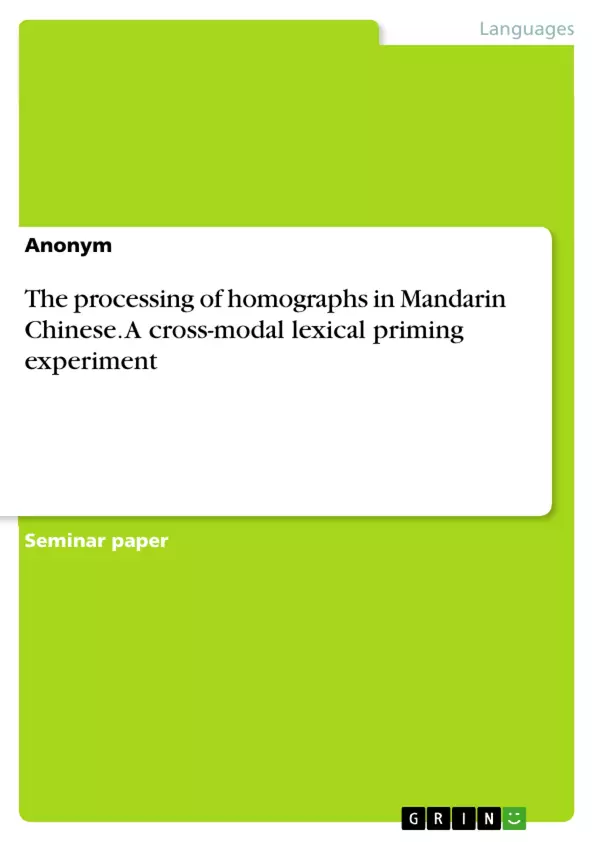This paper will report a cross-modal lexical priming experiment which focuses on Mandarin homographs of varying degrees of semantic relatedness. In this experiment, the time course of context effects and the effect of semantic relatedness on lexical ambiguity resolution will be examined.
The phenomenon of lexical ambiguity is one of several types of ambiguities and is pervasive in almost all natural languages. When a listener hears an ambiguous word with multiple meanings in a sentence, do they activate all meanings associated with that ambiguous word automatically regardless of the preceding context, or do they make use of the preceding context to eliminate irrelevant meanings? This is one of the fundamental empirical questions in the study of language processing, id est lexical ambiguity resolution.
Two main types of models have been suggested by the research literature for this issue. The first one is the exhaustive access model, which proposes that all meanings of an ambiguous word will be accessed automatically following the occurrence of the word and that the context can only help to select the appropriate meaning at a later stage. The second contrasting model is the interactive access model, which assumes that the context can facilitate the contextually appropriate meaning of an ambiguous word at the initial stage of lexical access if the prior context provides a strong bias towards the appropriate meaning. As the literature shows, what undoubted is that the context plays an important role in the selection of a contextually appropriate meaning of the ambiguous words, the main debate lies in how early the context effects take place in the lexical processing.
So far, these two models have been mostly examined in Indo-European languages, particularly in English. There has been just a scarcity of this line of research in Chinese, one of the most important East Asian languages, which differs significantly from Indo-European languages in terms of its unique psycholinguistic properties in phonological, lexical and syntactic structures. These properties can thus pose a good challenge to verify and complement the examination of these models in lexical processing from a different perspective.
Inhaltsverzeichnis (Table of Contents)
- Introduction
- Models of lexical ambiguity resolution
- The exhaustive access model
- The interactive access model
- Issues in lexical ambiguity resolution
- Position of visual target in cross-modal priming
- Types of lexical ambiguity
- The relatedness of multiple meanings
- The processing of Chinese homographs: an experiment
- Method
- Results
- Discussion
- Conclusion
Zielsetzung und Themenschwerpunkte (Objectives and Key Themes)
This paper investigates the processing of lexical ambiguity in Mandarin Chinese, focusing on the role of context and semantic relatedness in resolving ambiguity. The study aims to examine whether context effects take place early or late in lexical processing and to determine the extent to which the semantic relatedness of multiple meanings influences ambiguity resolution. The paper also seeks to contribute to the understanding of lexical ambiguity resolution in a language with a unique logographic writing system.
- Lexical ambiguity resolution in Mandarin Chinese
- The influence of context on lexical processing
- The role of semantic relatedness in ambiguity resolution
- The comparison of exhaustive access and interactive access models
- The implications of Chinese logographic orthography for lexical processing
Zusammenfassung der Kapitel (Chapter Summaries)
The introduction outlines the phenomenon of lexical ambiguity and introduces the two main models of ambiguity resolution: the exhaustive access model and the interactive access model. It also highlights the unique characteristics of Chinese language, particularly its large number of homophones and its logographic writing system.
Chapter 2 elaborates on the exhaustive access and interactive access models. The exhaustive access model posits that all meanings of an ambiguous word are accessed automatically, while the interactive access model suggests that context can influence the selection of meaning from the initial stage of lexical access.
Chapter 3 discusses factors that have been postulated to influence lexical ambiguity resolution beyond context, including the position of visual target in cross-modal priming, types of lexical ambiguity, and the relatedness of multiple meanings.
Chapter 4 presents a cross-modal lexical priming experiment focusing on Mandarin homographs of varying degrees of semantic relatedness. This experiment investigates the time course of context effects and the impact of semantic relatedness on ambiguity resolution.
Schlüsselwörter (Keywords)
This paper focuses on lexical ambiguity resolution, Mandarin Chinese, homographs, exhaustive access model, interactive access model, context effects, semantic relatedness, cross-modal priming, logographic writing system.
- Arbeit zitieren
- Anonym (Autor:in), 2021, The processing of homographs in Mandarin Chinese. A cross-modal lexical priming experiment, München, GRIN Verlag, https://www.grin.com/document/1041899



